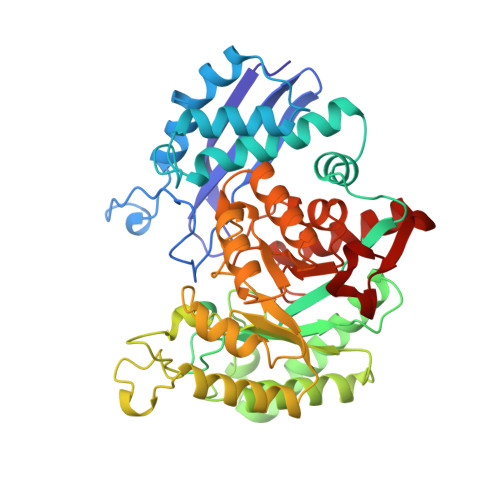A carboxylate oxygen of the substrate bridges the magnesium ions at the active site of enolase: structure of the yeast enzyme complexed with the equilibrium mixture of 2-phosphoglycerate and phosphoenolpyruvate at 1.8 A resolution.
Larsen, T.M., Wedekind, J.E., Rayment, I., Reed, G.H.(1996) Biochemistry 35: 4349-4358
- PubMed: 8605183
- DOI: https://doi.org/10.1021/bi952859c
- Primary Citation of Related Structures:
1ONE - PubMed Abstract:
The equilibrium mixture of yeast enolase with substrate, 2-phospho-D-glycerate (2-PGA), and product, phosphoenolpyruvate (P-enolpyruvate), has been crystallized from solutions of poly(ethylene glycol) (PEG) at pH 8.0. Crystals belong to the space group C2 and have unit cell dimensions a = 121.9 A, b = 73.2 A, c = 93.9 A, and beta = 93.3 degrees. The crystals have one dimer per asymmetric unit. Crystals of the equilibrium mixture and of the enolase complex of phosphonoacetohydroxamate (PhAH) are isomorphous, and the structure of the former complex was solved from the coordinates of enolase-(Mg2+)2-PhAH [Wedekind, J. E., Poyner, R. R., Reed, G. H., & Rayment, I. (1994) Biochemistry 33, 9333-9342]. The current crystallographic R-factor is 17.7% for all recorded data (92% complete) to 1.8 A resolution. The electron density map is unambiguous with respect to the positions and liganding of both magnesium ions and with respect to the stereochemistry of substrate/product binding. Both magnesium ions are complexed to functional groups of the substrate/product. The higher affinity Mg2+ coordinates to the carboxylate side chains of Asp 246, Glu 295, and Asp 320, both carboxylate oxygens of the substrate/product, and a water molecule. One of the carboxylate oxygens of the substrate/product also coordinates to the lower affinity Mg2+-thus forming a mu-carboxylato bridge. The other ligands of the second Mg2+ are a phosphoryl oxygen of the substrate/product, two water molecules, and the carbonyl and gamma-oxygens of Ser 39 from the active site loop. The intricate coordination of both magnesium ions to the carboxylate group suggests that both metal ions participate in stabilizing negative charge in the carbanion (aci-carboxylate) intermediate. The epsilon-amino group of Lys 345 is positioned to serve as the base in the forward reaction whereas the carboxylate side chain of Glu 211 is positioned to interact with the 3-OH of 2-PGA. The structure provides a candid view of the catalytic machinery of enolase.
- Institute for Enzyme Research, University of Wisconsin-Madison, 53705, USA.
Organizational Affiliation:



















